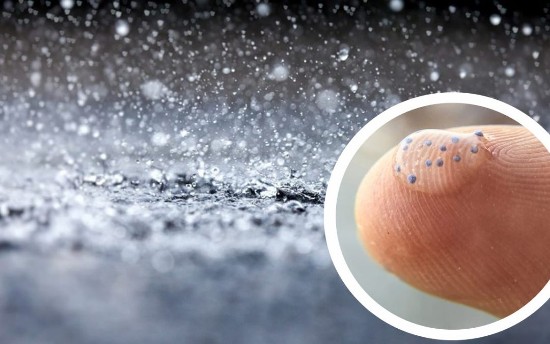In 2020, Sean Fleming, a senior writer at the World Economic Forum wrote, “If you saw 120 plastic bottles fall from the sky, you’d be right to feel concerned.” Multiply that by millions and you can begin to get the picture of how plastic is polluting the air we breathe, the water we drink, and the food we eat. Plastic rain is the new acid rain.
An Australian study identifies seven types of plastic of which three have a density less than or equal to water which is 1.0. These three are polypropylene, found in bottle caps, which has a density of 0.92, polyethylene used for plastic bags which has a density of 0.95, and polystyrene with a density of 1.01 and used in items such as disposable utensils, foam cups, plates, bowls and fishing floats. These three make up 75% of the nanoplastics found in water and hence through the water cycle and evaporation, in the air. What goes up eventually falls essentially meaning our skies, today, rain plastic.
Does that mean we are drinking plastic when taking water from municipal sources? Highly unlikely say those in charge of water treatment. Plastic water bottles, however, are another story. Recent research suggests microplastic contamination exists in 93% of bottled water.
That same study disagrees with those who mind our municipal water noting that microplastics are to a lesser extent to be found in tap water. Some commercial water filters used to improve the taste and quality of tap water can remove microplastic contamination but not all filters are created equal.
A study done by the Indian Institute of Technology on rainwater falling over the city of Patna, India, noted nine types of microplastics have been detected. Patna is known for high air pollution levels with the microplastics that come down over the city largely coming from land-based sources.
With all that plastic coming down in the rain, the rivers, lakes and oceans of the world are seeing a growing plastic smog as described in research published in March 2023 in the journal PLOS ONE. Based on 2019 data, researchers estimated then as much as 4.9 million tons of plastic particles can be found floating in the ocean. Based on current plastic consumption and waste, by 2040 that number is expected to grow by 2.6 times.
The study mentioned in the previous paragraph is authored by researchers from California’s 5 Gyres Institute, UC Riverside, Moore Institute for Plastic Pollution Research, the California State Water Resources Control Board, and San Francisco State University, as well as contributions from Stockholm University, ABR, Inc. Environmental Research and Services, Fairbanks, Alaska, the Universidad Católica del Norte in Chile, and the Minderoo Foundation in Western Australia. Using tow samples collected from 11,777 stations on the world’s oceans, the research noted that observed concentrations of microplastics were affected by wind and waves. The more of the two meant microplastics were driven below the sampling sieves and nets used to determine concentrations. Thus the final estimated amount included compensation for the undercount. The adjusted numbers used observed data from previous ocean sampling in making the final estimate.
The study concluded that the amount of microplastic in the oceans has increased significantly since 1990 with dramatic increases from 2006 onward which the researchers ascribed to the exponential growth in global plastic production.
The Earth’s water cycle takes water from surface sources and through evaporation turns it into water vapour which then forms clouds and ultimately precipitation in the form of rain and snow. With the ocean filling with more microplastics that are so tiny they easily become airborne in the water cycle, it is no wonder that the world today is raining plastic.
In 2022, the United Nations adopted a resolution to end plastic pollution. A treaty is expected to follow bringing the world’s nations together to tackle the full life cycle of plastic from production to end of life. Will this stop plastic rain from continuing to fall? No. It will, however, lead to standardized monitoring of plastic pollution in the environment to prevent more microplastics from being added to the water cycle of the planet. Getting rid of what is already baked in will require novel technology solutions which as of now don’t exist.
















